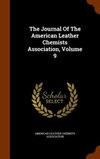在打浆过程中用大豆粉及时抑制胰蛋白酶活性,防止生皮受到酶损伤
IF 0.5
4区 工程技术
Q4 CHEMISTRY, APPLIED
Journal of The American Leather Chemists Association
Pub Date : 2023-06-01
DOI:10.34314/jalca.v118i6.7659
引用次数: 0
摘要
酶法打浆对生产清洁、柔软和高产皮革非常重要。然而,由于质量传递缓慢,加弹剂在皮革中的水解反应迅速,导致粒面层的酶水解时间长于中间层,因此容易对皮革胶原纤维造成破坏,导致粒面松散或粒面受损。考虑到胰蛋白酶是最常见的糊化剂,因此在用胰蛋白酶处理划线生皮一定时间后,使用含有环保型库尼茨胰蛋白酶抑制剂(KTI)的大豆粉(SF),以适时抑制其在谷粒中的活性,避免出现糊化缺陷。用荧光标记的胰蛋白酶和 KTI 标记的生皮的荧光显微照片显示,当 KTI 在标记生皮一定时间后加入时,只能覆盖表层,而胰蛋白酶可以完全渗透生皮。如果在 2 小时后向打浆浮渣中加入足量的 SF,则可有效减少胰蛋白酶对牛皮胶原蛋白的破坏。尤其是在浸渍 8 小时后,纹理表面仍保持完好。此外,使用 SF 几乎不会影响中层纤维的分散,从而确保了皮革的柔软性。总之,适时抑制谷粒中胰蛋白酶的活性可防止皮革损伤,提高皮革质量。本文章由计算机程序翻译,如有差异,请以英文原文为准。
Preventing Enzymatic Damage to Hides by Timely Inhibition of Trypsin Activity with Soybean Flour during Bating Process
Enzymatic bating is important for producing clean, soft, and high-yield leather. However, it is prone to cause damage to hide collagen fibers and result in loose grain or damaged grain surface due to the longer enzymatic hydrolysis time of the grain layer than the middle layer caused by the slow mass transfer and the rapid hydrolysis reaction of the bating agent in hide. Considering trypsin is the most common bating agent, soybean flour (SF) that contains environmental friendly Kunitz trypsin inhibitor (KTI) was used after delimed hides were treated with trypsin for a certain time to opportunely inhibit its activity in the grain and avoid bating defects. The fluorescence micrographs of hides bated with fluorescently labelled trypsin and KTI showed that KTI could cover only the surface layers when it was added after bating for a certain time, whereas trypsin could penetrate the hide completely. When sufficient SF was added to the bating float at 2 h, the damage to hide collagen caused by trypsin was effectively reduced. In particular, the grain surface remained intact after bating for 8 h. The decrease in the strength of leather caused by bating was also reduced. In addition, the usage of SF scarcely affected the fiber dispersion of the middle layer, thereby ensuring the softness of leather. In summary, opportunely inhibiting the activity of trypsin in the grain could prevent hide damage and improve the quality of leather.
求助全文
通过发布文献求助,成功后即可免费获取论文全文。
去求助
来源期刊

Journal of The American Leather Chemists Association
工程技术-材料科学:纺织
CiteScore
1.30
自引率
33.30%
发文量
29
审稿时长
3 months
期刊介绍:
The Journal of the American Leather Chemists Association publishes manuscripts on all aspects of leather science, engineering, technology, and economics, and will consider related subjects that address concerns of the industry. Examples: hide/skin quality or utilization, leather production methods/equipment, tanning materials/leather chemicals, new and improved leathers, collagen studies, leather by-products, impacts of changes in leather products industries, process efficiency, sustainability, regulatory, safety, environmental, tannery waste management and industry economics.
 求助内容:
求助内容: 应助结果提醒方式:
应助结果提醒方式:


